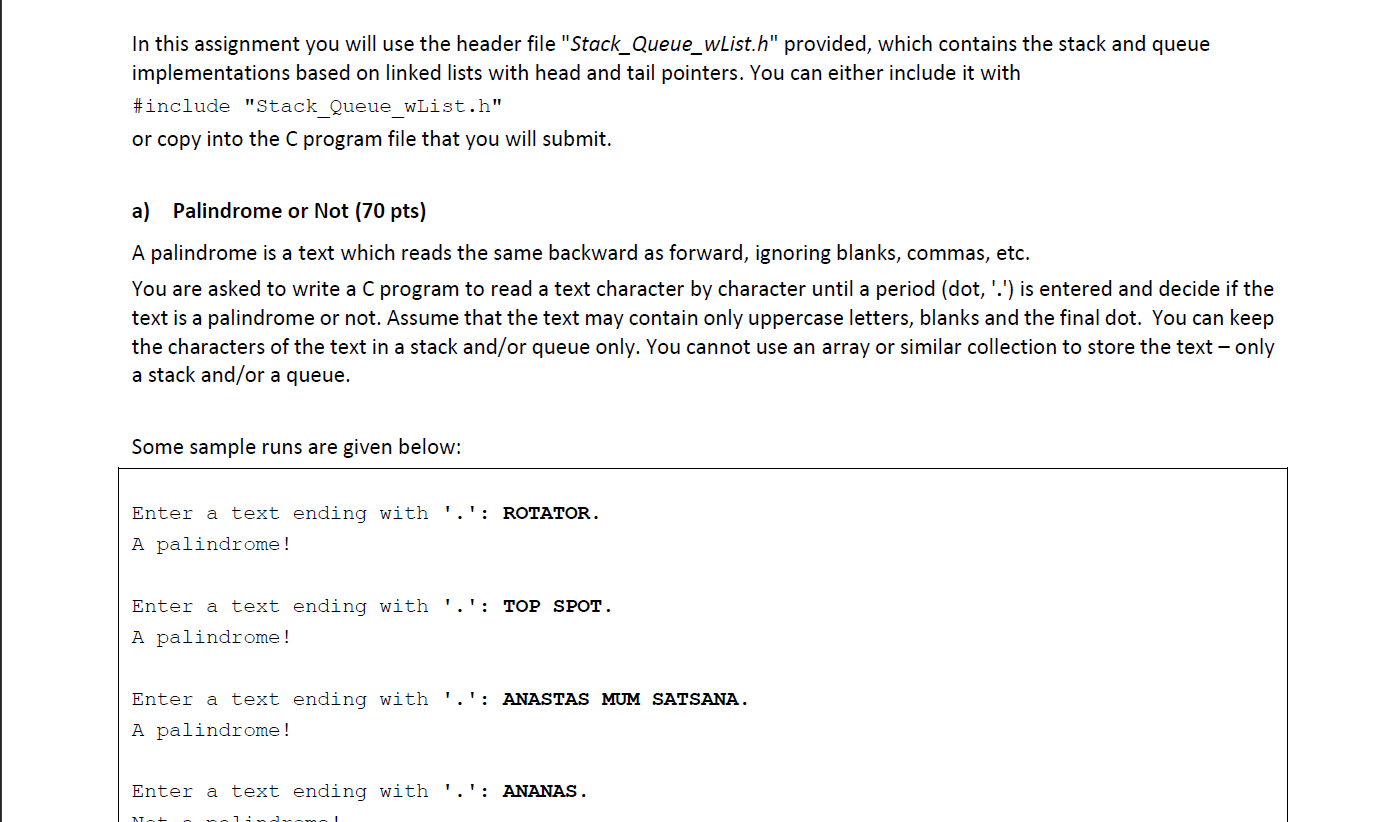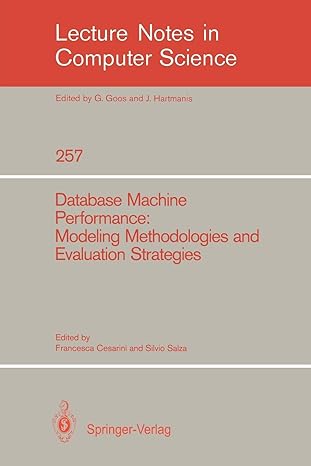Question
We need to make a palindrome check program which takes an input of only uppercase spaces and a final dot. we MUST have to use
 We need to make a palindrome check program which takes an input of only uppercase spaces and a final dot.
We need to make a palindrome check program which takes an input of only uppercase spaces and a final dot.
we MUST have to use the header file as mentioned which contains the following code
#include
// This version of Linked List keeps also a tail pointer to the last Node. // Hence, it becomes O(1) to access the last one or to insert to the end.
struct Node { int val; struct Node *next; };
struct List { struct Node *head, *tail; int size; };
// LIST is new name for "struct List" typedef struct List LIST;
void LInit(LIST *l){ // initialize list to empty l->head = l->tail = NULL; // pointers to first and last node l->size = 0; // number of nodes }
int LGetPos(LIST *l, int x) { struct Node *p; int i=0; // go through all nodes for (p=l->head; p!=NULL; p=p->next) if (p->val == x) return i; // found, so return i++; // not yet, go to next return -1; // not found in the list }
int LGetAt(LIST *l, int pos) { struct Node *p=l->head; int i; if(pos >= l->size) { // we have less items printf("LGetAt: Position not exist "); return -99; } // last one, so directly return if(pos==l->size-1) return l->tail->val; // go to position for(i=1; inext; // go to pos return p->val; // return item at pos }
void LInsert(LIST *l, int x, int pos) { struct Node *new, *p; // p: previous node int i; if(pos > l->size) { // we have less items printf("LInsert: Position not possible "); return; } // create a new node new = (struct Node *) malloc(sizeof(struct Node)); new->val = x; if(pos==0) { // insert to start new->next = l->head; l->head = new; // only one, so it also tail if(l->size==0) l->tail=new; } else if(pos==l->size) { // insert to end l->tail->next = new; l->tail = new; new->next = NULL; } else { // insert after p p = l->head; for(i=1; i
void LDelete(LIST *l, int pos) { struct Node *p, *d; // p: previous int i; if(pos >= l->size) { // we have less items printf("LDelete: Position not exist "); return; } if(pos==0) { // delete first node d = l->head; l->head = d->next; } else { // delete after p p = l->head; for(i=1; i
int LIsEmpty(LIST * l){ return (l->size == 0); }
int LSize(LIST * l){ return (l->size); }
void LDisplay(LIST *l) { struct Node *p; printf("List: "); for(p=l->head; p!=NULL; p=p->next) printf("--> %d ", p->val); printf(" "); }
int LHeadOf(LIST *l) { if (!LIsEmpty(l)) return l->head->val; else { printf("LHeadOf: Linked list empty "); return -99; } }
int LTailOf(LIST *l) { if (!LIsEmpty(l)) return l->tail->val; else { printf("LHeadOf: Linked list empty "); return -99; } }
// STACK is new name for "struct List" typedef struct List STACK;
void SInit(STACK *s) { LInit(s); // call Init of Link List }
void SPush(STACK *s, int item) { // call Insert of Link List to insert item at position 0 LInsert(s, item, 0); }
int SIsEmpty(STACK *s) { // call IsEmpty of Link List return LIsEmpty(s); }
int SPop(STACK *s) { if(LIsEmpty(s)) { printf("SPop: Stack empty "); return -99; } else { int t=LGetAt(s, 0); // get top element into t LDelete(s, 0); // delete it from stack return t; // return t (ex-top element) } }
// QUEUE is new name for "struct List" typedef struct List QUEUE;
void QInit(QUEUE *q) { LInit(q); // call Init of Link List }
void QInsert(QUEUE *q, int item) { // call Insert of Link List to insert item to the end (pos size) LInsert(q, item, LSize(q)); }
int QIsEmpty(QUEUE *q) { // call IsEmpty of Link List return LIsEmpty(q); }
int QRemove(QUEUE *q) { if(LIsEmpty(q)) { printf("QRemove: Queue empty "); return -99; } else { int t=LGetAt(q, 0); // get first element into t LDelete(q, 0); // delete it from list return t; // return t (ex-first element) } }
In this assignment you will use the header file "Stack_Queue_wList.h" provided, which contains the stack and queue implementations based on linked lists with head and tail pointers. You can either include it with #include "Stack Queue_wList.h" or copy into the C program file that you will submit. a) Palindrome or Not (70 pts) A palindrome is a text which reads the same backward as forward, ignoring blanks, commas, etc. You are asked to write a C program to read a text character by character until a period (dot,':') is entered and decide if the text is a palindrome or not. Assume that the text may contain only uppercase letters, blanks and the final dot. You can keep the characters of the text in a stack and/or queue only. You cannot use an array or similar collection to store the text - only a stack and/or a queue. Some sample runs are given below: Enter a text ending with '.': ROTATOR. A palindrome! Enter a text ending with '.': TOP SPOT. A palindrome! Enter a text ending with '.': ANASTAS MUM SATSANA. A palindrome! Enter a text ending with '.': ANANAS. NL 71Step by Step Solution
There are 3 Steps involved in it
Step: 1

Get Instant Access to Expert-Tailored Solutions
See step-by-step solutions with expert insights and AI powered tools for academic success
Step: 2

Step: 3

Ace Your Homework with AI
Get the answers you need in no time with our AI-driven, step-by-step assistance
Get Started


